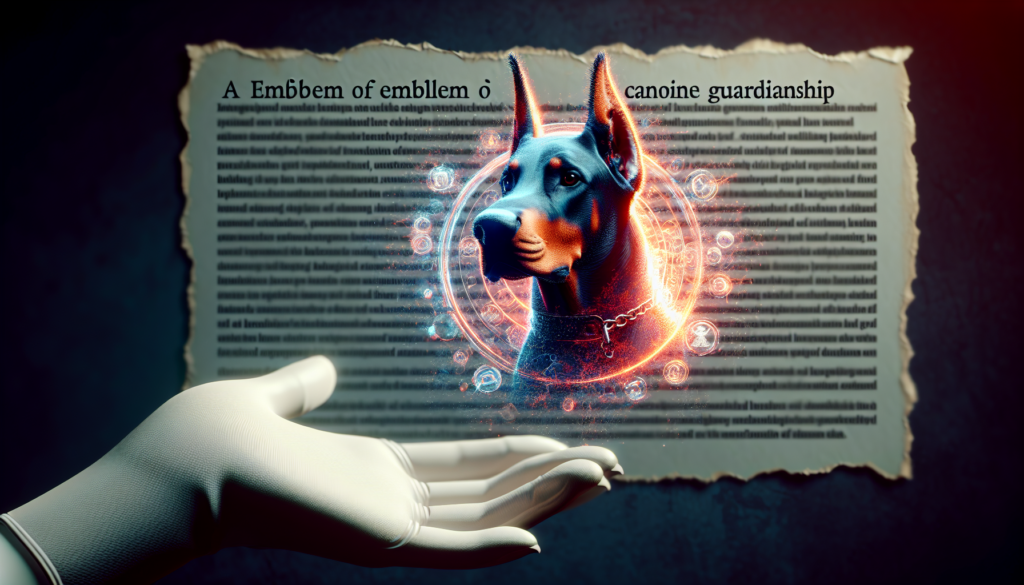If you’re considering getting a Doberman as a family pet or for protection, you might be wondering at what age they develop their famous protective instincts. Well, the good news is that Dobermans are known for their natural protective nature, but when exactly does it start to emerge? In this article, we will explore the fascinating journey of a Doberman’s development and reveal the age at which their protective instincts begin to shine. So, grab a cup of tea and get ready to learn all about these loyal and steadfast companions.

Development of Dobermans
Dobermans, like all dogs, go through various developmental stages as they grow. Understanding these stages is crucial to comprehending their behavior and protective instincts. Let’s delve into the different phases of a Doberman’s development.
Early Stages of Life
When a Doberman is born, it enters a fragile and dependent stage. During this period, which lasts up to eight weeks, they are entirely reliant on their mother for warmth, nourishment, and socialization. It is crucial for breeders to provide a stimulating and nurturing environment during this time to ensure healthy development and the cultivation of protective traits.
Socialization Period
Between the ages of eight and twelve weeks, Dobermans enter their socialization period. This is a critical stage where they start exploring their surroundings, interacting with littermates, and learning to interact with other dogs and humans. It is during this period that they develop important social skills that will shape their protective instincts in the future.
Adolescence
Around the age of six months, Dobermans enter adolescence, which lasts until they are two years old. This is a period of significant physical and hormonal changes. During adolescence, Dobermans may exhibit signs of increased independence, assertiveness, and territorial behavior. It is essential for owners to provide clear guidance and consistent training during this time to mold their protective tendencies into responsible and well-behaved behavior.
Factors Influencing Protective Behavior
Protective behavior in Dobermans is influenced by a combination of genetics, training, socialization, and environment. Understanding these factors can give valuable insights into the development of a Doberman’s protective instincts.
Genetics
Genetics play a crucial role in a Doberman’s protective behavior. Breeding practices that select for protective traits can enhance a Doberman’s natural inclination to guard and protect its family. Responsible breeders meticulously choose parent dogs with balanced temperaments, sound nerves, and a strong drive to protect.
Training and Socialization
Proper training and socialization are fundamental in shaping a Doberman’s protective behavior. Early exposure to various environments, people, animals, and situations helps them develop confidence and appropriate responses to potential threats. Positive reinforcement training techniques, coupled with consistent and patient guidance, can channel their protective instincts into well-behaved and reliable behavior.
Environment
The environment in which a Doberman grows up can heavily influence its protective behavior. A calm and stable home environment with positive experiences and interactions can foster a sense of security and trust in the dog. On the other hand, negative or traumatic experiences can potentially trigger defensive or aggressive responses. Providing a safe and nurturing environment is crucial in developing a well-rounded and protective Doberman.
Socialization and Training
Socialization and training are pivotal in shaping a Doberman’s behavior, including their protective instincts. Let’s explore the importance of early socialization, training methods, and obedience training.
Importance of Early Socialization
Early socialization is vital in fostering a well-balanced and protective Doberman. Exposing them to a wide range of experiences, people, animals, and environments at a young age ensures they grow into confident and adaptable dogs. This socialization process helps them develop trust, learn appropriate responses, and differentiate between genuine threats and harmless situations.
Training Methods
Training methods used to shape a Doberman’s protective behavior should focus on positive reinforcement and consistency. Reward-based training techniques, such as treats, praise, and play, help establish a strong bond between the owner and dog while encouraging desired behaviors. It is essential to avoid harsh punishment or dominance-based methods that can undermine their trust and lead to fear or aggression.
Obedience Training
Obedience training is essential for a protective Doberman. Teaching basic commands like “sit,” “stay,” and “come” allows you to maintain control and redirect their protective instincts when necessary. Obedience training strengthens the bond between owner and dog, enhances communication, and provides the groundwork for responsible behavior in various situations.
Signs of Protective Behavior
Recognizing signs of protective behavior in your Doberman is essential for understanding their needs and ensuring their well-being. Here are some common indicators of protective behavior.
Alertness
One of the primary signs of protective behavior in a Doberman is heightened alertness. They have a natural instinct to be vigilant and aware of their surroundings. If your Doberman is constantly scanning their environment, responding to sounds or movements, and exhibiting a focused and attentive demeanor, it is likely a sign of their protective instincts in action.
Territorial Behavior
Dobermans are known for their territorial instincts. If they display signs of guarding specific areas, such as their home or yard, and react defensively towards unfamiliar people or animals encroaching on their territory, it is indicative of their protective nature. Barking, growling, and displaying body posture that suggests protectiveness are common behaviors associated with territorial instincts.
Protectiveness Towards Family
Dobermans are fiercely loyal and protective of their families. They will go to great lengths to keep their loved ones safe. If your Doberman shows a strong attachment to family members, exhibits watchful behavior when strangers are around, or actively positions themselves between their family and perceived threats, it is a clear sign of their protective instincts.

Age Milestones in Protective Behavior
Protective behavior in Dobermans is not fixed but evolves as they mature. Understanding the age milestones associated with their protective instincts can provide guidance on what to expect during different stages of their development.
6-12 Months
Between six and twelve months, Dobermans start developing and refining their protective instincts. They may become more watchful, alert, and possessive of their family. This is an important time to reinforce positive behaviors and provide consistent training to ensure their protective instincts are channeled appropriately.
1-2 Years
By the age of one, a Doberman’s protective instincts are usually more pronounced. They may display increased territorial behavior and a heightened wariness of strangers. It is crucial during this phase to reinforce boundaries, maintain consistent training, and provide a balanced and nurturing environment to guide their protective instincts in a positive direction.
2-3 Years
Between the ages of two and three years, a Doberman’s protective instincts typically stabilize. They have developed a solid foundation of training and socialization and are more confident in their role as protectors. However, it is important to continue reinforcing their training, providing mental stimulation, and ensuring their overall well-being to maintain their protective behavior.
Common Misconceptions about Protective Behavior
Misconceptions about protective behavior in Dobermans can lead to misunderstandings and false assumptions. Let’s debunk two common misconceptions:
Instinctive vs. Learned Behavior
Protective behavior in Dobermans is often mistakenly attributed solely to instinct. While they do have inherent protective instincts, their behavior is also significantly shaped through training, socialization, and environment. It is crucial to understand that their protective nature is a combination of instinctive drives and learned behaviors.
Timelines Vary among Dogs
Another common misconception is that all Dobermans will exhibit protective behavior at the same age. Just like humans, each dog is an individual and may develop at a different pace. Some Dobermans may display protective tendencies earlier, while others may take more time. It is important to be patient, consistent, and adaptive in training and socializing your Doberman to ensure their unique needs are met.
Breed-Specific Characteristics
Dobermans have distinct temperament traits and instincts that contribute to their protective behavior. Understanding these breed-specific characteristics provides valuable insights into their overall behavior.
Doberman Temperament
Dobermans are known for their loyal and protective nature. They are fiercely devoted to their families and quickly develop strong bonds. Their intelligence, fearlessness, and alertness make them ideal candidates for protection and guard work. However, it is crucial to balance their protective instincts with a calm and patient demeanor to ensure their behavior aligns with their role as family companions.
Instinctual Guarding Tendencies
Dobermans have natural instincts for guarding and protection. These instincts, combined with their heightened awareness and loyalty, make them excellent watchdogs and protectors. They possess an innate drive to keep their loved ones safe, but it is essential to provide appropriate training and socialization to ensure their guarding tendencies are channeled responsibly.
Understanding Doberman Behavior
Understanding the intricacies of a Doberman’s behavior is key to building a strong bond and healthy relationship. Let’s explore some essential aspects to consider:
Individual Differences
Each Doberman has a unique personality. It is crucial to observe and understand your dog’s individual characteristics to tailor training and socialization approaches that suit their needs. Some Dobermans may be naturally more protective, while others may have a more laid-back temperament. Recognizing these differences allows you to provide appropriate guidance and support.
Reading Body Language
Dobermans, like all dogs, communicate through body language. Understanding their body language cues can help you gauge their mood, stress levels, and potential protective responses. Dilated pupils, raised hackles, stiff body posture, and tense facial expressions may indicate heightened protectiveness or unease. Learning to read their body language allows you to respond appropriately and provide reassurance or intervention when necessary.
Positive Reinforcement
Positive reinforcement is a powerful tool in shaping a Doberman’s behavior. Rewarding desired behaviors, such as calmness, focus, and appropriate protective responses, strengthens their bond with you and encourages them to repeat those behaviors in the future. By using treats, praise, and play as rewards, you can foster a positive association with protective instincts and ensure their behavior aligns with your expectations.
Tips for Raising a Protective Doberman
Raising a protective Doberman requires consistent training, socialization, and responsible care. Here are some tips to help you navigate this journey successfully:
Early Socialization
Start socializing your Doberman early to expose them to a variety of people, animals, and environments. Gradually introduce them to new experiences, always focusing on positive interactions. This will help them develop the confidence and social skills necessary for appropriate protective behavior.
Consistent Training
Consistency is key when training a protective Doberman. Establish clear boundaries and expectations, and ensure that all family members follow the same rules and reinforce the same behaviors. Consistent training helps them understand their role as protectors and reinforces your leadership.
Proper Health Care
Providing proper health care for your Doberman is essential. Regular veterinary check-ups, vaccinations, and preventive measures against common health issues ensure their overall well-being. A physically healthy Doberman is better equipped to exhibit appropriate protective behavior.
Conclusion
Dobermans are known for their loyalty, intelligence, and protective nature. Understanding the factors that influence their protective behavior, recognizing signs of protectiveness, and providing appropriate training and socialization are crucial for raising a well-rounded and responsible Doberman. By fostering a positive and nurturing environment, establishing clear boundaries, and being attentive to their individual needs, you can navigate the journey of raising a protective Doberman with confidence and joy.
